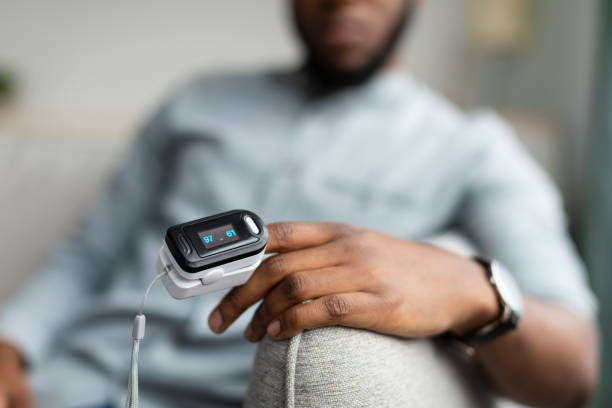Pulse oximetry is a widely used, non-invasive method for monitoring blood oxygen saturation (SpO2) levels. It measures the percentage of oxygen-bound hemoglobin in the arterial blood. These measurements give a physician crucial insights into a patient’s respiratory health. However, certain factors like temperature fluctuations and skin pigmentation can impact the accuracy of home pulse oximeters.
This article explains how these factors affect SpO2 readings and why reliable, validated devices are essential for accurate home measurements.
Understanding Pulse Oximetry and the Accuracy of Home Pulse Oximeters
Before we explain how temperature affects SpO2 readings, we will provide an overview of how pulse oximetry works. A pulse oximeter is a probe attached to a patient’s fingertip, earlobe, or other peripheral sites. With proper placement, the probe emits two wavelengths of light, usually red and infrared, through the tissue to detect oxygenated and deoxygenated hemoglobin absorption characteristics. By analyzing the differential absorption of light, the device calculates the oxygen saturation level in the blood.
Effect of Temperature on the Accuracy of Home Pulse Oximeters
Tissue, temperature changes, and room temperature can all impact the accuracy of SpO2 measurements. By understanding the relationship between temperature and SpO2 measurements, clinicians can work to ensure consistent and accurate monitoring of a patient’s respiratory status. The following sections outline the factors that contribute to poor accuracy.
Tissue Perfusion
Temperature can affect peripheral blood flow and tissue perfusion. When hands and fingers are cold, blood flow to these areas decreases. Cold impacts the signal strength that pulse oximeters use to determine oxygen saturation.
Higher temperatures, on the other hand, cause vasodilation. Heat increases blood flow, potentially enhancing signal strength. Research shows that during cold conditions, signal quality can decrease by as much as 54% for infrared and 30.6% for red signals, affecting the accuracy of home pulse oximeters.
Oxygen Dissociation Curve
Temperature changes also influence the oxygen dissociation curve. The curve is the relationship between oxygen saturation and the partial pressure of oxygen in the blood. Higher temperatures shift the curve to the right, which reduces hemoglobin’s affinity for oxygen.
This can result in lower SpO2 readings even if actual oxygen levels remain stable. The variation in readings is why reliable and validated pulse oximeters that account for or mitigate these fluctuations are needed.
Probe Performance
Extreme temperatures can impair pulse oximeter probes, compromising measurement accuracy. Cold conditions can cause the probe to stiffen, leading to poor tissue contact, while high temperatures may degrade the probe materials or introduce artifacts that interfere with light transmission.
can impact the accuracy of home pulse oximeters, leading to disparities in readings and raising health equity concerns.
Mitigating Temperature Effects on Home Pulse Oximetry
What are the best ways for a patient to increase POx measurement accuracy when using a pulse oximeter at home? To improve the accuracy of home pulse oximeters, patients can take the following steps to counteract temperature-related fluctuations.
- Select an Optimal Measurement Site: Choosing a site with stable temperature and good perfusion, like the fingertip or earlobe, can help improve accuracy.
- Control Ambient Temperature: Maintaining a moderate room temperature reduces the impact of environmental extremes on SpO2 measurements. Proper ventilation also contributes to consistent and accurate readings.
- Use Reliable Devices: Devices like Tenovi’s cellular-connected pulse oximeter and the Nonin pulse oximeter are designed for reliable home use and can maintain accuracy in different conditions.
Skin Pigmentation and Accuracy of Pulse Oximeters
Research shows that pulse oximeters may be less accurate on individuals with darker skin pigmentation. Higher melanin levels absorb more light and can interfere with the device’s signal processing. Studies have found that pulse oximeters tend to overestimate SpO2 in individuals with darker skin.
The inaccuracy can lead to under-recognition of low oxygen levels and delayed treatment. Given these disparities, it’s essential to use devices that account for variations in skin tone to ensure equitable health outcomes.
Reliable Devices for Accurate Home Pulse Oximetry
The accuracy of home pulse oximeters is vital for patients monitoring their oxygen levels remotely. Low-cost pulse oximeters often provide inaccurate readings for patients with darker skin pigmentation and varied temperatures. This can result in potential misdiagnosis and inequitable healthcare outcomes.
Devices like Tenovi’s cellular-connected pulse oximeter and the Nonin pulse oximeter are designed to be highly reliable in varied home environments. These devices use validated technology and advanced signal processing to consistently read temperature and skin tone variations.
Research shows that fingertip pulse oximeters from Nonin performed significantly better than competing models under dyspnea and low perfusion conditions. The Nonin Model 3230, offered by Tenovi, was designed to provide accurate readings for patients of varying skin tones to ensure patients receive equitable care.
Tenovi’s cellular-connected oximeter is particularly beneficial for remote patient monitoring. It transmits data directly to care service and healthcare providers, eliminating the need for smartphones or Wi-Fi and ensuring immediate access to accurate SpO2 data.
Understanding the Accuracy of Home Pulse Oximeters
Accurate home pulse oximetry is crucial for effective remote monitoring and management of respiratory conditions. Factors like temperature and skin pigmentation can influence readings. Therefore, healthcare providers and patients should be aware of these potential effects.
Using reliable, validated devices designed for home use and proper technique helps ensure that remote oxygen saturation readings are dependable and that patients receive timely, appropriate care. Providing a quick start guide or instructional video for patients using remote monitoring devices can improve patient understanding and confidence in home monitoring.
Tenovi serves companies interested in offering remote patient monitoring solutions to healthcare providers. Schedule your free demo and consultation today.


